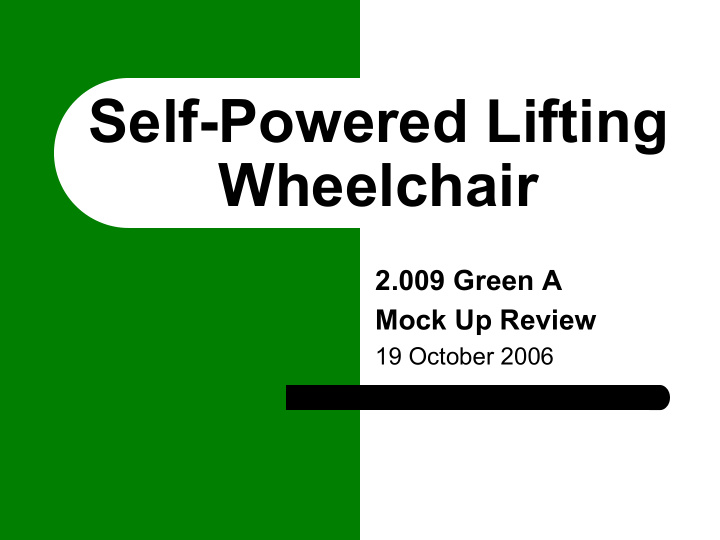



Self-Powered Lifting Wheelchair 2.009 Green A Mock Up Review 19 October 2006
Survey Results l Disability Types of Users Interviewed – Paraplegia – Quadriplegia – Multiple Sclerosis (MS) l Top Concerns – Weight – Safety – Communication – Reach Green A
Customer Needs l Manual Lift – Improves communication – Improves reach l Safety – FDA Regulations l Accessibility – ADA Regulations l Portability l Stability Green A
Technical Aspects l Design Considerations – Ergonomics – Regulations – Usability – Stability l Critical Mechanisms – Lifting – Pivoting Green A
Ergonomics Design Considerations l Comfort l Push Force l Reach – Little to no compromise Green A
Regulations Design Considerations l ADA regulations – Accessibility l FDA regulations – Class II device – Straight to market Green A
Usability Design Considerations l Easy to Lift – Low force – Few repetitions l Portability – Weight l Mobility – Maintain standards Green A
Stability Design Considerations l Center of Mass (CM) – Controlled in raised and lowered positions l Stable on inclines – Up to 35 degrees Green A
Lifting Critical Mechanisms l Lifting Mechanisms – Rack & Pinion – Air Pistons – Locking Collar l Raised Height – Aids in Communication – Extends Independent Living Green A
Pivoting Critical Mechanisms l Pivoting Mechanism – Pivot – Bearings l Stability – Moving CM – Meets current regulations l Range of Motion – No Compromise Green A
Affordability l Market comparison – iBot: $25000+ – Powered standing chairs: $8600+ l Customer Data – User comfort range of $1500-$7000 – Target price: $2000 – Possible insurance coverage Green A
Recommend
More recommend